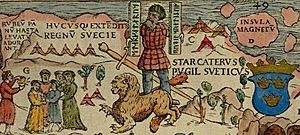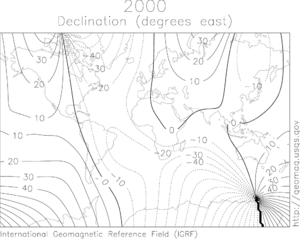North Magnetic Pole facts for kids

Imagine the Earth as a giant magnet! The North Magnetic Pole is a special spot on our planet where the Earth's magnetic pull goes straight down into the ground. There's another similar spot called the South Magnetic Pole at the other end of the Earth.
This magnetic pull is why your compass works. Everywhere else on Earth, the magnetic field points towards the North Magnetic Pole. This helps a compass needle point generally north, guiding explorers and travelers.
The North Magnetic Pole is not the same as the North Pole. The North Pole is the very top of the Earth, like the tip of a spinning top. The North Magnetic Pole is a different point that moves around.
Contents
What is the North Magnetic Pole?
The Earth has a huge magnetic field, almost like a giant bar magnet inside it. This field creates two main points where the magnetic force is strongest and points straight down or up. These are the North and South Magnetic Poles.
A compass needle is a small magnet. It lines up with the Earth's magnetic field. This is why it usually points towards the North Magnetic Pole.
How is it Different from the North Pole?
The North Pole is a fixed point on the Earth's surface. It is where the Earth's axis of rotation comes out. Think of it as the very top point if you imagine the Earth spinning like a basketball on a finger.
The North Magnetic Pole is different. It's where the Earth's magnetic field lines point straight down. Because these two poles are not in the same place, a compass does not always point exactly to the geographic North Pole. However, the difference is usually small enough for most navigation.
The Wandering Pole
The North Magnetic Pole is not fixed in one spot. It slowly moves or "wanders" over time. Scientists track its position carefully.
For example, in 2001, scientists believed it was near Ellesmere Island in northern Canada. Its location was around 81°18′N 110°48′W / 81.3°N 110.8°W. By 2005, it had moved slightly to about 82°42′N 114°24′W / 82.7°N 114.4°W.
By 2015, the pole had moved even further east. It was thought to be beyond Canada's Arctic territory, at approximately 86°18′N 160°00′W / 86.3°N 160.0°W. This movement means maps and navigation systems need to be updated regularly.
Why the Poles Aren't Opposite
The Earth's magnetic field is not perfectly balanced or "symmetrical." This means that if you drew a straight line from the North Magnetic Pole to the South Magnetic Pole, it would not pass directly through the very center of the Earth. This is because the magnetic field is created by the movement of molten iron deep inside the Earth, which is a complex process.
See also
- North Pole, Alaska
- In Spanish: Polo norte magnético para niños


